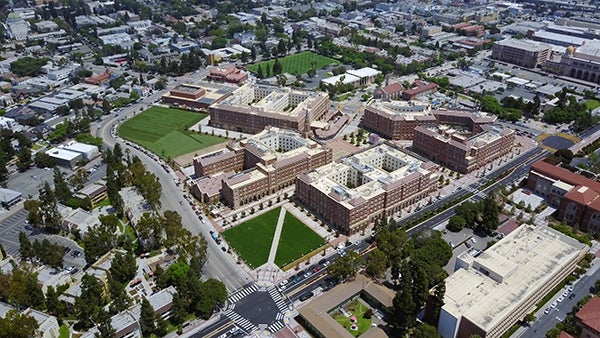Below USC Village, the Land Tells Two Centuries of L.A. History
The site of USC Village has come a long way from scrubby underbrush to home of USC’s largest residential complex.
LAND
Long before there was USC Village, there was the land on which it now stands—scrubby and open. When the Spanish arrived to lay claim to California, indigenous people known as the Tongva (Gabrielino) inhabited the Los Angeles basin. The original Spanish civilian settlement that would become the city of Los Angeles grew in the 1780s around the area today known as Olvera Street in downtown L.A. During the era of Spanish and Mexican ranchos, the long trip from El Pueblo de Los Angeles to the lonely site of the future USC was probably best attempted on horseback.
After California was ceded to the United States, one man who certainly visited the area where USC Village now stands was prominent surveyor Henry Hancock. He would have walked along what is today Hoover Street, dragging the chains and stakes used to mark the borders of the city of Los Angeles under the U.S. Land Commission’s patent of 1856. (Hoover formed the city’s western edge. The city’s southwestern corner stood at the site of what is now Metro’s Exposition Park/USC rail station.) Within a few decades of Judge Robert Maclay Widney’s founding of USC in 1880, maps of Los Angeles show houses dotting expansive fields north of the university.
As USC and L.A. matured, the North University Park neighborhood thrived. Street blocks like 31st and 32nd between Hoover and Orchard Avenue, which no longer exist, once were lined with homes. Many took up residence in Victorian and Craftsman houses in North University Park, and some of these structures still stand. Just after the turn of the 20th century, a police station opened at Jefferson Boulevard and Hoover— the first outside downtown L.A. The site would later host a bank, then a Denny’s restaurant. Today, it features an entrance to USC Village. Maps from a 1921 real estate atlas in USC Libraries’ Special Collections show a nursery in the area. They also show a theater on Jefferson between McClintock Avenue and Hoover. Known as University Theater, it become the Realart Theater, and then the Trojan Theater, which showed its last movie in 1952.
Businesses continued to grow along Jefferson in the latter half of the century. Photos show shops like Tuxedo Center and Hensley Jewelers. There was also a pharmacy, camera shop, travel agency and cleaners. But in the 1970s, a redevelopment project sought to stimulate renewal in the area. Besides seeing new apartment buildings and a fire station built on Jefferson, students and neighbors could frequent the new University Village shopping center—which opened in 1976 on the site of a former meatpacking plant. Trojans may remember businesses from the time: Tam’s, a stationery and book store; Silverwoods, a men’s clothing shop; and the 32nd Street Market, to name a few.

USC purchased the University Village shopping center in 1999, and by the 2000s, it was time for a fresh start on the property. The center was demolished in 2014, opening a new chapter of Los Angeles history for students and neighborhood residents alike.
